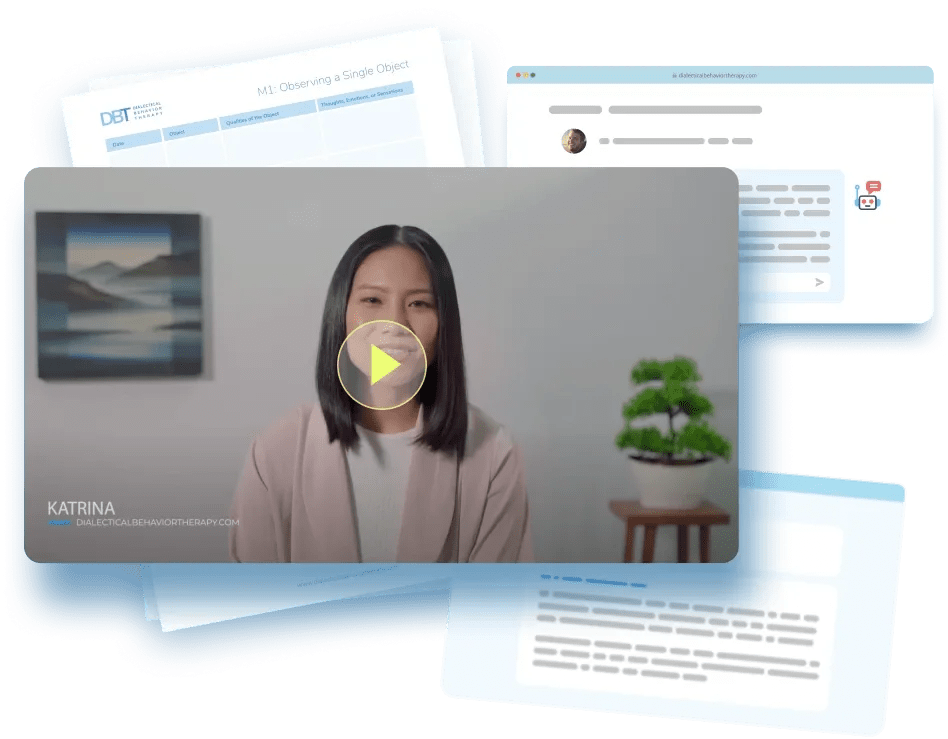What is Distress Tolerance?
Imagine this scenario. You wake up feeling very well rested, enjoy the most delicious breakfast you’ve had, and find the train ride to work a breeze. But when you arrive at work, you are called by your manager and are informed that you are being laid off.
Even if you are in full control of yourself, there are things that are beyond your control. These painful events, which will be called “crises'' in this article, are a normal part of life. Everyone will experience extreme emotional distress like depression, anger, or fear.
This is where distress tolerance skills come into play.
Distress tolerance is your ability to manage actual or perceived emotional distress. Whether the crisis is big or small, your tolerance determines how you decide to manage the situation. Distress tolerance skills help you build those tolerance muscles so you are more well-equipped whenever these crises come.
Distress Tolerance as a DBT Module
One of the modules of Dialectical Behavior Therapy (DBT) focuses on developing distress tolerance skills. This is crucial because emotional crises can continue to occur even while you actively work on other aspects of your psyche.
With the skills listed in this module, you can learn how to cope with these crises and accept them without making them worse.
This page currently lists 13 skills to master in DBT Distress Tolerance.
List Of Distress Tolerance Skills And Techniques In DBT
The Distress Tolerance skills are divided into three sub-skills: “Crisis Survival Strategies”, “Reality Acceptance Skills”, and “Tolerance Building”.
- 1
Crisis survival strategies: These skills are intended to help you get through immediate and intense emotional pain without making the situation worse. Note that these are not designed to solve the crisis, but to survive it.
- exercise T1: Cost Benefit Analysis Helps you assess what problematic behaviors are costing you and whether it is worth making a change.
- exercise T3: Distracting Activities Create a list of distracting activities to use when you start to approach an emotional crisis.
- exercise T4: RESISTT Technique Techniques to help you deal with unhealthy urges during emotional crises.
- exercise T5: Grounding Reconnect with the present moment when thoughts about the past or future are becoming unproductive.
- exercise T8: Grounding Use your five senses to help reduce out-of-control emotions.
- exercise T10: TIPP Calm emotions with Temperature, Intense exercise, Paced breathing, and Progressive muscle relaxation.
- 2
Reality Acceptance skills: These skills focus on accepting reality as it is, not as you want it to be, which is crucial in reducing the suffering caused by non-acceptance.
- exercise T6: Willingness vs. Willfulness See how to approach situations flexibly to become more effective.
- exercise T7: Radical Acceptance Learn how to become accepting of realities without unproductive emotions.
- exercise T9: Actions Based on Values Aligning your actions with values helps you deal with difficult situations.
- 3
Tolerance Building: This involves developing your tolerance for distress.
How Do These Distress Tolerance Skills Help?
In practicing the distress tolerance skills found on this page, you gain tools to calm yourself in challenging situations, reducing the likelihood of impulsive actions driven by intense feelings.
These skill building exercises include practicing techniques like distraction (focusing your mind on something other than the distress), self-soothing (engaging in activities that are comforting), and radical acceptance (accepting the reality).
By mastering these skills, you're better equipped to handle moments of extreme anxiety, fear, anger, frustration, and discomfort! This leads you to a more balanced emotional state and improved overall mental health.
How Does Printable Distress Tolerance Worksheets Work With Therapy?
Printable distress tolerance worksheets are valuable tools in therapy. Here's how they contribute to the therapeutic process:
- Structured Learning and Practice. These worksheets provide a structured way for clients to learn and practice distress tolerance skills. The exercises, prompts and guides help you understand how to apply the techniques. They can be used during therapy sessions or practiced on your own at home.
- Enhancing Self-awareness. As you work through the worksheets, you become more aware of your emotional triggers and responses. The worksheets may ask you to reflect on past experiences of distress, identify your usual reactions, and consider more effective coping strategies.
- Reinforcing Skills Learned in Therapy. Worksheets are an extension of the skills you have learned so far, like mindfulness, by allowing you to apply what you have learned so far.
- Personalized Approach: Therapists can select or customize worksheets that best fit your specific needs and challenges to make the process more personalized and effective.

How to Practice Distress Tolerance Skills in Real-Life
DBT emphasizes a variety of practical and effective strategies for diverting your attention away from intense emotions, such as:
- Engaging in regular physical activity helps you apply the skills found in Distracting Activities and TIPP. You do not have to enroll in a gym – walking or running daily around the neighborhood or just doing some jumping jacks at home will do.
- Volunteering at a shelter or participating in a drive is a beneficial way to engage in Distracting Activities, a key concept in managing intense emotions. By focusing your efforts on helping others, you shift your attention away from distressing thoughts and feelings.
- Implementing self-soothing techniques that you have learned is a vital step in calming yourself during times of stress or emotional upheaval. These techniques, including deep breathing, mindfulness meditation, or engaging in a comforting activity, are designed to reduce anxiety and promote relaxation.
- Make it a point to affirm what you most need to hear each day. Choose affirmations that resonate with you and feel authentic. Examples include, “I possess more bravery than I realize” and “I am capable of tackling difficult challenges.”
How Do You Build Distress Tolerance?
Apart from engaging with the exercises, watching the videos, and completing the worksheets provided in our DBT skills section, there are several other strategies that you can use to build your distress tolerance:
- Practice Mindfulness. Remember the first module? Regular application of the mindfulness techniques keeps you in the present moment, priming yourself for managing distress emotions, thoughts, and feelings.
- Develop Healthy Coping Mechanisms. The easiest is to engage with activities like joining a club, or gym or taking up home hobbies. Having a trusted friend or getting a therapist you can talk to is also a great option!
- Learn and Apply Acceptance Skills. Sometimes, accepting things as they are, rather than fighting them, is crucial. Techniques like radical acceptance can be powerful in helping you manage distress.
- Set Realistic Goals. Set small goals to start your journey, then gradually build up as you become confident with your newfound skills. For example, you can practice mindful breathing for five minutes but gradually increase it to ten when you are comfortable.
- Celebrate Small Wins. When you reach a goal or a first, remember to celebrate! This will motivate you to continue and focus on meeting more wins.

Subscribe.
Get the DBT course. Free!
Get your full access to our 26-week DBT course.
Lessons emailed to you twice a week.

Frequently Asked Questions
Distress tolerance and emotion regulation are both modules of DBT, but they serve distinct functions.
Distress tolerance is all about helping you withstand negative emotions or stressful situations without becoming overwhelmed. It focuses on equipping you with tools to endure emotional pain in situations when a solution isn't possible.
Emotion regulation, on the other hand, involves helping you understand, accept, and effectively manage emotions. It's about experiencing emotions appropriately and expressing them in a healthy way.
The DBT Distress Tolerance skills and exercises found on this site are also suitable for teenagers. We suggest you give them a try!
Numerous indicators can suggest that you have low frustration tolerance. Here are a list of questions that can help you determine whether you have a low distress tolerance:
- Do you find yourself avoiding challenging emotions, people, or situations?
- Do you tend to react excessively or inappropriately in certain situations?
- Do you notice a lack of interest or curiosity in things around you?
- Do you overlook or disregard the emotions of others?
- Do you often become angry quickly?
- Are you prone to showing irritability or moodiness?
- Do you seek immediate satisfaction and show impatience for the results?
- Do you adopt a pessimistic outlook or frequently exaggerate negative aspects?
- Are you often impatient with people and circumstances?
- Do you hold beliefs that are not supported by scientific or logical reasoning?
If you find yourself answering “yes” to most of these, you probably have low distress tolerance.
If you answered “no” to these, you have a high distress tolerance.
It is very worthwhile to teach children distress tolerance. Kids who can handle emotional distress well can easily control their emotions and connect well with other people. Here are some ideas to engage kids in when moments of emotional crises occur:
- Square Breathing: Coach the kid to breathe in, hold, breathe out, hold, each lasting about four minutes. For smaller children, it could be effective to help them imagine they are blowing a bubble.
- Playing, Running, and Jumping: Running, jumping, and playtime can keep the children off the emotional crisis (intense exercise part of TIPPS). Playing along could also help younger children.
- Dancing: Time to play that fun nursery rhyme! Dancing can also be a great way to teach children distress tolerance. Movement is a part of self-soothing activities.
- Read or Make up Stories: This is another distracting activity. Joining them in engaging a story also helps a lot!
- Drawing or Coloring: Art can be a great way for kids to express their emotions and calm their minds.
References
- NIH National Library of Medicine. "Distress Tolerance and Psychopathological Symptoms and Disorders: A Review of Empirical Literature among Adults"
- NIH National Library of Medicine. "Mindfulness as taught in Dialectical Behaviour Therapy:
A scoping review" - Linehan, Marsha. "Why Distress Tolerance Skills Are Necessary"
- Idaho Youth Ranch. "5 DBT Skills to Help Your Kids Manage Stress"




Hello! Loving all the work you are doing. Should I go through all these distress tolerance exercises in order, one-per-day? Or should I stay on one until I have mastered the skill?
ADMIN – Hi Dan,
Go through the skills in order, they often build on each other. You might find some of the exercises more useful and more challenging than others. Spend extra time on those exercises. You may also want to come back to the exercises that you find the most useful and the most challenging as you progress through the material. Glad to hear it has been useful to you!
I just found your website and will start working the topics, etc.
My primary issue is distress tolerance. Is it ok to start with that and learn those skills? I ask as I find it hard to work on Mindfulness skills when I feel so anxious and have difficulty focusing.
Thank you. Deborah
Hi Deborah.
Yes, it is okay to start with distress tolerance if you find those skills are the most important for you now. I like the way you are taking the materials and reshaping them to meet your needs.
You’ll see at the top of the page that Distress Tolerance is an extension to Mindfulness taught in the first lessons. This page also points to the Distress Tolerance worksheets and techniques as building on Mindfulness and directs followers to use those techniques learned in the Mindfulness modules to get the most from the future lessons. The fact that you find the Mindfulness exercises difficult for you speaks to the need for them. While the goal isn’t for you to be frustrated or discouraged, you will gain the most benefit with DBT using the foundational experiences to help expand and grow your ability to learn new productive skills. In general, the things that are easy for you are the things you should spend the least amount of time on, not the most. I realize your post was written years ago but hopefully this helps someone else with the same concern you once had.
I believe as long as we keep going and utilize our new skills on a daily basis- each day, one skill, one MOMENT at a time… we can do this!
I am not ready for DBT. I need more talk therapy before I get started.
A therapist once told me that distress tolerance is NOT about going from a 10 to a Zero. It’s about going from a 10 to a 5. The expectation to get rid of our distress is not practical. The goal is to reduce our distress to a tolerable level so we can then use the tools in the other sections.
I love this site! I’m a social worker and will be sharing this information with my colleagues and clients.
I’ve had the book for a few years now but it’s a bit tense to go through the entire book just to find a worksheet, nice it’s all in one place and it’s easy to navigate.
Thanks for the excellent information!
Wish I was aware of this 12 years ago.
In my opinion my child could benefit from the Distress Tolerance therapy but professionals are saying she is too unwell to start any therapy. I am at a lost as to what they think is going to make her get better before she can do any therapy.
Thank you so very much for these resources. What a gift you have given so many who struggle. Thank you.
This website is amazing! Currently, I am working on a DBT resource guide for K-12 classrooms, and I would love to hear your feedback about how to teach ‘Turning the Mind.’ Thank you so much for all you do!
I went to a DBT group as a young adult and it helped me more than i could have imagined. I highly recommend it for anyone. Iv struggled with Bipolar but have come a long way. I’m now in my mid 30s and was looking to refresh my knowledge. So grateful for this site. Thank you!
A nice therapy for BPD
I love this site. I mastered my CBT and wanted to try DBT as I have bipolar disorder. It seems very affective for this as well as personality disorders. Also, thank you as I could not afford DBT.
Thanks so much for sharing this <3
I am unemployed again mainly due to BPD, I cannot afford to pay for DBT right now. I have also recently lost a relationship I deeply cared about because of this. What you do makes a world of difference.
Hi. I am now 64yo and wanted to share that almost 20years ago I was in a post-hospitalization day program that taught DBT classes. I had been extremely depressed yet was ready to be discharged. I remember vividly that I wanted these principles to “click” for me bc I felt a desperate need to get better. I am afraid that at that time so long ago, I didn’t really understand “how” to incorporate the theory into practice. Her, so many years later, I am finding so much benefit from this program! I think it is bc I am (thankfully) at a better place now yet to me the central thing for me is practice and examples of HOW to use the info in everyday life. Thank you so much for making this series and especially for making it free. I sincerely appreciate your work. —Mary
This is the longest ive managed to stick to any self-help or online course!
After 4 or 5 group sessions with a DBT trained therapist, I resonated so much, after years and years of trying to ‘get better’, then a new diagnosis of bp2, adhd and PMDD. This course is engaging and effective! I worked on mindfulness for many years meditating with an app, I think this has helped immensely get through the first module, and I can’t wait to continue. Can’t thank you enough.